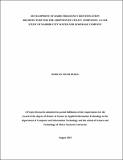Development of radio frequency identification architecture for the adoption by utility companies: a case study of Nairobi City Water and Sewerage Company

View/
Date
2019-08Author
Njuhi, Dorcas Kuria
Type
ThesisLanguage
enMetadata
Show full item recordAbstract
Accurate meter readings, timely and correct bills have become an important aspect of water metering systems. Additionally, anomalies such as leakage and bursts in water pipelines have significant consequences to the environment and lead to financial constraints to the water companies. Since monitoring leakages and bursts in the water distribution networks, capturing accurate and dependable measurements for billing, troubleshooting and analysis is a challenging task, the need to develop a reliable and effective water metering system is essential for water loss reduction in the distribution networks and for accurate and timely bills and accurate measurements. Radio Frequency IDentification technology (RFID) has emerged as an effective technology for monitoring critical infrastructure such as water pipelines, and for meter reading. However, RFID is not monolithic, it is used in conjunction with other applications. In this study, an Automatic Meter Reading (AMR) system using RFID is presented. RFID based AMR, is the remote collection of consumption data from customers’ utility meters using Radio Frequency (RF) technologies. It aims to eliminate the traditional method of recording meter readings manually whereby a meter reader visits every meter location usually at predetermined intervals or time and records the current meter values manually. The main objectives of this study were; to identify a viable RFID technology to enhance billing accuracy with streamlined meter reading and for leak detection; to establish and assess the effects of RFID technologies to the consumers and Water Service Provider (WSP) and to develop an RFID technology architecture for water based utility companies.The target population was all the 1,810 employees from the six different regions in Nairobi City Water and Sewerage Company (NCWSC). A sample size of 328 employees from the six different regions in NCWSC was used and Stratified sampling technique was adopted to determine the appropriate representation using Dempsey and Dempsey formula. Questionnaires were used as data collection tools, which focused on the company staff and descriptive analysis method was used for data analysis where Statistical Package for Social Sciences (SPSS) tool was used. Qualitative data from the open ended questions was analyzed using content analysis technique. The average score for effects of RFID technology on consumers was found to be 3.95, meaning respondents agreed that the adoption of RFID technology has great benefits to the consumers. The average score for effects of RFID technology on WSP was found to be 3.99, implying that the respondents agreed that RFID technology offers numerous solutions to the challenges faced by WSP’s. The findings of this study are expected to be beneficial to utility companies more specifically a water-based industry. The study recommends the adoption and implementation of RFID based AMR technology in a water- based industry to enhance and improve efficiency and effectiveness in their operations.
Publisher
Africa Nazarene University
Subject
Radio frequency identificationRadio frequency identification--Utility companies
Radio frequency architecture
Radio frequency architecture--Nairobi Water and Sewerage Company
